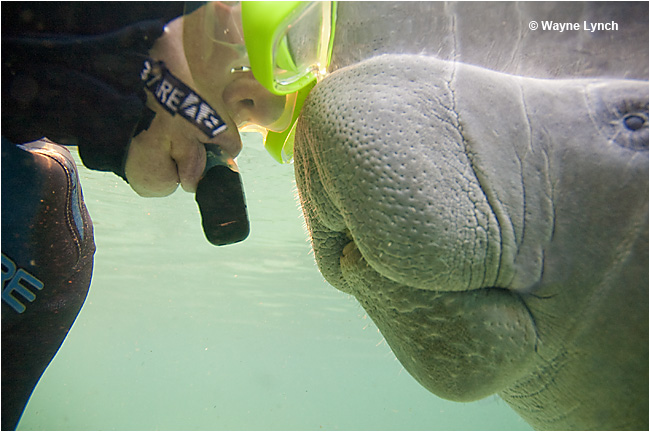
Manatee Madnessby Dr. Wayne Lynch
Three winters ago I went searching for manatees for the first time. My destination was the west coast of Florida and the small city of Crystal River. A decade earlier a Japanese photographer friend, who had published three books on manatees, had given me the idea and told me how much fun it would be, but it took my wife giving me an underwater camera housing for my birthday to seal the deal.
The West Indian manatee ranges throughout the Caribbean islands and along the eastern coast of Mexico and Central America. In winter, Florida is at the northern edge of the animals' range. Between November and March the water temperatures in the Gulf of Mexico can dip down to 10°C. Manatees are a tropical marine mammal and such cool temperatures are lethal to them. To survive the winter season, manatees in Florida must either escape south to the Caribbean or seek refuge in one of the warm freshwater springs that well up from the state's underground aquifer at several locations along the coast. Crystal River is the location of one such spring, and typically harbours over 500 manatees, one of the largest overwintering aggregations in Florida. The water coming out of the springs is a life-giving 23°C and at times the manatees may be stacked up like cord wood.
After my first winter in Florida in 2008/2009 I was hooked. I've observed and photographed wildlife on every continent and in more than 60 countries and the manatee is unlike anything I expected. It was endearingly gentle, often surprisingly unwary, and frequently comically photogenic. Besides this, I know of no other wild animal on Earth that will approach humans for no other reason than tactile stimulation - the desire to be stroked and scratched lightly. This past winter, a juvenile animal, a manatee "teenager", swam over to me, wrapped his flippers around my lower leg and started to gently mouth the wet suit over my calf with his bristly snout. From my calf he moved up to my knee, and from there up to my thigh. I pulled away at that point because the inquisitive animal was getting dangerously close to some personally prized anatomical areas. He was not dissuaded by my actions and he turned his attention to my face and mask, ending the encounter by gently brushing my chin with his whiskers. My wife now jokingly calls me the "manatee whisperer".
Photographing manatees is a relatively easy affair. All you need is a wet suit, a snorkel and mask, and some kind of protective housing for your camera. Underwater camera equipment is quite specialized but here are some suggestions. When I started working with the manatees, I used a 6-megapixel Canon Point-and-Shoot in a Plexiglas housing. The housing cost around $300 and the system produced some pretty good JPEG images. I soon wanted better quality and I immediately jumped up to an Ikelite (www.ikelite.com) housing for my Nikon digital SLR. The housing cost nearly $3000 so it's an expensive option but if you want professional quality images this is a good route to go. Ewa (www.ewa-marine.com) makes flexible housings for digital SLRs that cost much less than an Ikelite. The Ewa system is basically a thick plastic bag with a glass port on the front. I've never used one but I suspect they would work quite well in the shallow depths where manatees are found. Currently my underwater lens of choice is an 18-70mm zoom. Many manatee photographers use wider-angle lenses, even fisheyes, but I think they distort the foreground too much and make the animals look pumpkin-headed.
This past winter, 2010/2011, I made my third trip to manateeland and am now collaborating with Dr. James Powell on a book, The Florida Manatee - A Complete Guide to Their Biology and Behavior which will be published in 2013 by Johns Hopkins University Press. Of the many books I've worked on, the manatee is certainly not the most beautiful animal, or the most exciting. But there's no question the manatee is the most lovable and I guarantee its aquatic antics will make you laugh.
Links To Additional Resources
[ Top ]
|








